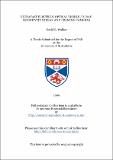Files in this item
Ultrafast electron-optical visible / X-ray-sensitivity streak and framing cameras
Item metadata
| dc.contributor.advisor | Sibbett, Wilson | |
| dc.contributor.author | Walker, David R. | |
| dc.coverage.spatial | [ca 220]p. | en_US |
| dc.date.accessioned | 2018-07-06T09:15:49Z | |
| dc.date.available | 2018-07-06T09:15:49Z | |
| dc.date.issued | 1990-07 | |
| dc.identifier.uri | https://hdl.handle.net/10023/15033 | |
| dc.description.abstract | In this thesis the development of ultrafast electron-optical streak and framing cameras having radiation sensitivities ranging from the visible to soft X-ray are discussed. A framing camera incorporating a vacuum demountable image tube with ultraviolet / soft X-ray sensitivity has been demonstrated to be capable of providing multiple, temporally separated, two-dimensional images with picosecond image exposure times under various operating conditions. Experimental evidence has been presented to show that this camera system can provide up to four high quality temporally separated images with an exposure time of 230 ps (FWHM) and inter-frame times of ~1ns under UV illumination. In the two-frame operation with soft X-ray illumination (generated using a laser produced plasma) image exposure times of as short as 100 ps (FWHM) and inter-frame times of 400 ps have been achieved. The dynamic spatial resolution of the camera has been shown to be ~8 lp/mm and ~5 lp/mm for the UV and soft X-ray sensitive devices respectively. A visible-sensitivity electron-optical single-shot streak camera possessing a novel travelling-wave deflection structure has been experimentally evaluated using a mode-locked cw ring dye laser. The limiting temporal resolution for this has been measured to be 300 fs and the merits of the travelling-wave deflection structure have been discussed. The implementation of this type of deflector geometry has also been demonstrated in conjunction with the vacuum demountable framing camera system. Computer aided design techniques have been utilised to further optimise the electron-optical framing tube configuration, and modifications have been proposed to enable shorter frame periods to be obtained while maintaining the dynamic spatial resolution. Results from preliminary evaluations of this design using a vacuum demountable UV-sensitive system are included. A novel streak camera design has also been proposed in which very high electrostatic photocathode extraction fields (up to 12 kV/mm) may be employed without danger of structural damage arising from electrostatic breakdown. This has been achieved by the removal of the usual mesh electrode placed in close proximity to the photocathode. Preliminary evaluations of a vacuum demountable UV-sensitive version of this camera geometry have been achieved which demonstrate a static spatial resolution of 80 lp/mm (when referred to the photocathode). | en_US |
| dc.language.iso | en | en_US |
| dc.publisher | University of St Andrews | |
| dc.subject.lcc | TK8360.C2W2 | |
| dc.title | Ultrafast electron-optical visible / X-ray-sensitivity streak and framing cameras | en_US |
| dc.type | Thesis | en_US |
| dc.contributor.sponsor | Paul Instrument Fund of the Royal Society | en_US |
| dc.contributor.sponsor | SERC | en_US |
| dc.contributor.sponsor | Atomic Weapons Establishment (Great Britain). AWE Aldermaston | en_US |
| dc.type.qualificationlevel | Doctoral | en_US |
| dc.type.qualificationname | PhD Doctor of Philosophy | en_US |
| dc.publisher.institution | The University of St Andrews | en_US |
This item appears in the following Collection(s)
Items in the St Andrews Research Repository are protected by copyright, with all rights reserved, unless otherwise indicated.

